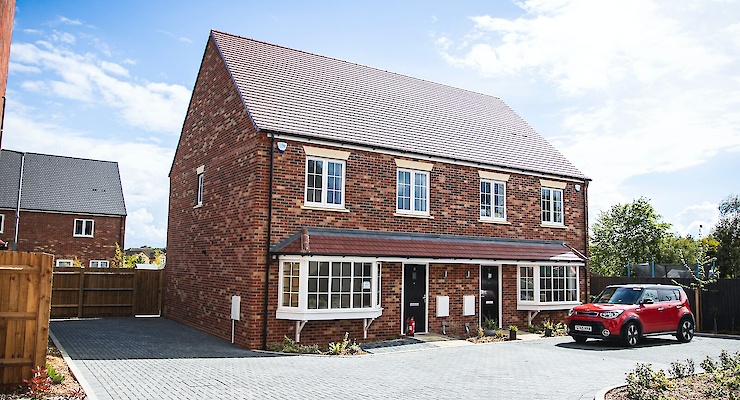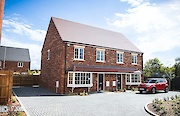


Head of Content

Mortgage Advisor & Director

New build properties are popular among house hunters, particularly first-time buyers, but there are specifics to be aware of if you are applying for a mortgage on one. In our guide to new build mortgages, you can learn all you need to know, compare deals for free, and find a broker who specialises in this property type.
What do mortgage lenders class as a ‘new build’?
Most mortgage lenders define a ‘new build’ property as one that was built or heavily renovated within the last two years, and not sold during that period. Getting approved for a mortgage on a home that fits this definition is rarely more difficult than it is for other property types, but there are times when complications can arise and expert advice is needed.
Things can be less straightforward if you are buying a new build home ‘off-plan’, which means the property is either under construction or the building work has not yet begun.
In this scenario, you are likely to have fewer lenders and mortgage deals to choose from, and are advised to speak to a mortgage broker before you apply for finance.
Eligibility criteria for new build mortgages
Eligibility criteria for mortgages on new build homes can sometimes be more stringent than for older properties, but this isn’t always the case. Below you will find some of the specific requirements some mortgage providers have for newly constructed properties:
- Property type: The mortgage deals available to you will depend on whether you are buying a new build house or a flat. New build flats are more difficult to get a mortgage on, and some lenders that offer them cap the loan-to-value (LTV) ratio at 85-60%.
- Deposit requirements: It is possible to get approved for a mortgage on a new build house with 5% of the property’s value to pay upfront as a deposit. New build flats, however, tend to require around 15% on average due to the lower LTV ratios.
- Warranty cover: Mortgage lenders need to see evidence that the property has an NHBC Buildmark, a 10-year warranty covering quality of construction. You can check whether the home you are buying has this in place on the NHBC website.
- Credit history: It is possible to get accepted for a new build mortgage with bad credit, but severe credit problems such as bankruptcies and repossessions, and problems that occurred recently can make approval more difficult.
Compare mortgage rates and deals
Interest rates for borrowers buying a new build property are no different than they are for people purchasing older home.
If you need a mortgage to buy a new build home, you can compare rates and deals from across the market for free on Teito and choose the one you want in real time.
As part of the service, you will be offered a free, no-obligation chat with a broker who specialises in new build mortgages. Choose your preferred option below to get started:

Compare new build mortgage rates for FREE
How much your mortgage will cost
You can work out what the monthly and overall repayments will be on a new build mortgage using our calculator below. Simply enter the amount you need to borrow, along with an interest rate, term length and repayment type to get some quick results.
Schemes you could apply for
There are schemes available that can help you secure a new build mortgage. Many of these are exclusive to first-time buyers, but there are options for most types of borrower, including:
- Mortgage Guarantee Scheme: The mortgages available through this government scheme are aimed at borrowers with 5-9% deposit. These products are an option for first-time buyers and homemovers seeking a new build or an older property.
- First Homes: This initiative is for first-time buyers and key workers who are buying a new build home. It offers discounts of between 30% and 50% on the property’s purchase price but is limited to homes with a value of £250k or less (£420k or less in London). You can apply if your household income is £80k or less (£90k in London).
- Deposit Unlock: This scheme from the Home Builders Federation is aimed at borrowers with only a 5% deposit to put down. It is available for new builds on selected developments and open to first-time buyers and homemovers, but availability is strictly limited to participating housebuilders and lenders.
- Help to Buy: The Help to Buy scheme is no longer available in most parts of the UK, but the Welsh version can still be applied for until March 2025. If you are buying a new build home in Wales, you could access this scheme with 5% deposit and receive an equity loan of 20% of the property’s purchase price to boost your prospects.
- Scottish shared equity schemes: Scotland has its own alternatives to Help to Buy - the New Supply Shared Equity (NSSE) and Open Market Shared Equity (OMSE) schemes - which are available to people buying new build properties.
You can read more about the schemes above through the links provided. If you are unsure which one to choose (if any) get in touch with us to speak to a mortgage advisor.
Available lenders and interest rates
Mortgage interest rates for borrowers buying new build properties can be slightly higher as lenders generally consider them higher risk. This is because of the uncertainty around whether the lender can recoup their debt in the event of a repossession and resale.
With no history to go off, the mortgage provider cannot be certain that the property will increase in value over time and raise enough capital to cover the necessary amount.
The vast majority of mortgage lenders will at least consider offering you a mortgage on a new build property, but the number of available providers to you will depend on the loan-to-value ratio and whether the property you are buying is a house or a flat.
The tables below show the number of accessible lenders based on these variables:
Houses & bungalows
This tables shows the number of lenders for new build houses and bungalows:
Loan-to-Value Ratio | Number of Lenders Available (Approx) |
95% | 16 |
90% | 45 |
85% | 63 |
80% | 69 |
75% | 74 |
Flats & maisonettes
This tables shows the number of lenders for new build flats and maisonettes:
Loan-to-Value Ratio | Number of Lenders Available (Approx) |
95% | 7 |
90% | 15 |
85% | 31 |
80% | 51 |
75% | 65 |
70% | 67 |
65% | 69 |
60% | 71 |
New build buy-to-let mortgages
It is possible to get a mortgage on a new build property you intend to use as a buy-to-let, but it can be more difficult than it is for older properties. This is largely due to the fact the property has no history of generating rent, so the potential rental income is uncertain.
Other objections some lenders will have relate to the potential devaluation of the property once tenants start living in it. If you are buying off-plan, this can add another hurdle as some providers might be concerned about delays postponing your rental income.
Rates and deposit requirements are higher in the buy-to-let market too, but the good news is that there are lenders who offer these mortgages on new build properties with minimal caveats. It is advisable to use a mortgage broker to filter out the lenders who don’t.
Read more on this topic in our complete guide to new build buy-to-let mortgages.
Pros and cons of new build properties
If you are applying for a mortgage to buy a new build home, it’s a good idea to research the advantages and disadvantages of this property type. The table below summarises them:
Advantages | Disadvantages |
Usually in better condition than older properties and need less maintenance and repairs in the first few years of purchase | Rates and deposit requirements can sometimes be slightly higher |
Generally more energy efficient | Delays can be costly if you are buying the property off-plan |
Housebuilder warranties cover minor repairs for a set period | New builds can be more expensive than comparable older properties |
No chain on the purchase side can mean a swifter completion with fewer delays | More difficult to get approved for a mortgage on certain property types, such as buy-to-let and flats |
Why choose Teito for your mortgage needs?
Now that you have read up on the specifics about getting a mortgage on new build property, you can compare rates and deals for free and access support from a broker on Teito.
Here are just some of the reasons people source their mortgage through us:
- You can access rates from 90+ lenders for free in seconds
- Our brokers can offer bespoke advice about new build mortgages
- We are 5-star rated on leading review websites
- You can secure an agreement in principle in seconds
Ready to compare rates and take advantage of a free, no-obligation chat with a broker who specialises in new build mortgages? Get started here.
FAQs
Mortgage offers are generally valid for six months, but for new build properties, it’s not uncommon to receive a longer one, of anywhere between nine and 12 months. This is to cater for borrowers who are buying off-plan and may run into delays.
If your mortgage offer is set to expire, it is possible to apply for an extension but this will only be granted at the lender’s digression. If your lender declines, things can get complicated and costly, and there is a possibility that you might have to re-apply for a mortgage from scratch.
Choosing an Adviser
Selecting a qualified and experienced mortgage adviser is of great importance. To choose a suitable adviser, evaluate their qualifications, experience, and reputation, and ensure they are regulated by the Financial Conduct Authority (FCA).
Read reviews from previous clients and make sure they provide a clear explanation of the products and services they offer, as well as the fees and charges associated with them.
Last updated 8 July 2024
08 July 2024
Added components to improve UX. Added sources





























































